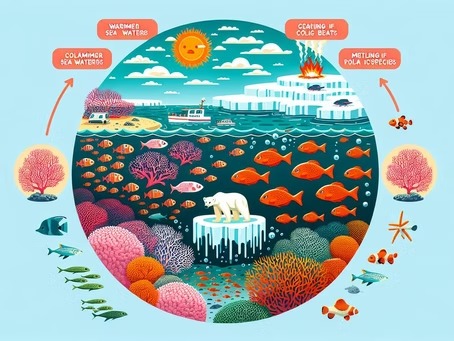Climate Change and Its Impact on Marine Life
Climate change is no longer a distant threat but a present-day crisis transforming the oceans. Rising temperatures, acidification, melting ice, and pollution are pushing marine ecosystems to the brink. These changes affect biodiversity, coastal communities, and global climate stability. Understanding the causes and consequences helps us take meaningful steps toward conservation and resilience.
Ocean Warming: A Heatwave Below the Waves
Coral Bleaching: A Disappearing Rainbow
As ocean waters heat up, corals expel the symbiotic algae they rely on, losing both their color and nutrition. The result is widespread coral bleaching, which weakens reefs and endangers the quarter of marine species that depend on them for shelter and food.
Species on the Move
Fish, plankton, and even predators are migrating poleward in search of cooler waters. This reshuffling disrupts food chains, alters ecosystems, and puts immobile species at risk of extinction.
Deep-Sea Shifts
Temperature and chemistry changes reach even the ocean depths. Sediment disruptions, altered nutrients, and increasing acidity threaten species adapted to highly stable conditions.
Ocean Acidification: A Silent Crisis
Shellfish and Corals Under Stress
As seas absorb carbon dioxide, acidity rises, weakening calcium carbonate structures. Oysters, clams, and coral larvae struggle to grow, threatening entire ecosystems that rely on reefs for survival.
Food Web Disruptions
- Phytoplankton decline, destabilizing the base of the food chain.
- Small fish and invertebrates diminish, leaving predators with less to eat.
- Top predators like sharks and tuna face dwindling resources.
The Ocean’s Buffering Limits
Oceans absorb vast amounts of CO2, but their buffering capacity is weakening. Scientists warn that tipping points could be near, threatening marine life and climate regulation.
Melting Ice Caps: A Reshaped Planet
Rising Sea Levels
Coastal flooding, saltwater intrusion, and disappearing habitats are direct results of melting polar ice and expanding seawater.
Loss of Polar Habitats
Polar bears, seals, and penguins lose breeding and hunting grounds. Disappearing ice also accelerates warming by reducing sunlight reflection.
Freshwater Influx and Salinity Shifts
Changing salinity alters breeding cycles, stresses marine species, and disrupts seagrass and other vital habitats.
Pollution: A Partner in Crime
Microplastic Invasion
Tiny plastic fragments infiltrate ecosystems, carrying toxins, altering sediments, and bioaccumulating through food webs.
Entangled Lives
Whales, turtles, and seabirds suffer from entanglement and ingestion of plastic debris, often leading to injury or death.
Pollution and Climate Change: A Toxic Duo
Pollution amplifies climate impacts, from algal blooms fueled by warming waters to submerged waste dumps releasing toxins.
Extreme Weather and Marine Havoc
Storms and Tsunamis
Coral reefs shatter, fish populations scatter, and seabeds transform under the force of natural disasters made worse by climate change.
Marine Heatwaves
Underwater heatwaves bleach reefs, disrupt plankton survival, and collapse food webs, leaving ecosystems struggling to recover.
Coastal Erosion
Rising seas and violent storms erode coastlines, threatening wildlife habitats and human communities alike.
Overfishing in a Changing Climate
Overfishing combines with warming seas to deplete stocks, disrupt habitats, and push ecosystems to collapse. Bycatch further threatens dolphins, turtles, and seabirds caught unintentionally in fishing gear.
Noise Pollution: The Ocean’s Distorted Soundscape
Whales and deep-sea species are disoriented by sonar, engines, and seismic activity. Chronic noise causes stress, hampers communication, and alters reproduction. Solutions like quieter ship design and speed limits show promise.
Hypoxia and Dead Zones
Runoff-fueled algal blooms consume oxygen, creating lifeless zones. Over 400 dead zones exist worldwide, threatening biodiversity and fisheries. Aeration systems and wetland restoration are among the solutions being tested.
Marine Climate Refugees
Tropical species move poleward, sometimes becoming invasive and displacing local wildlife. Conservationists face challenges protecting constantly relocating species, requiring flexible policies and international cooperation.
Signs of Hope
Marine Protected Areas
These underwater sanctuaries give ecosystems breathing space, allowing fish populations and coral reefs to recover.
Species Recovery
Humpback whales, blue whales, and green turtles are bouncing back thanks to global conservation efforts and hunting bans.
Grassroots Action
Community initiatives, from beach cleanups to sustainable seafood campaigns, prove that collective action makes a difference.
Conclusion
From coral bleaching to rising seas, climate change threatens every level of marine life. Yet with conservation, policy change, and collective effort, recovery is possible. The fate of the oceans is tied to ours, making action not just urgent but essential.

